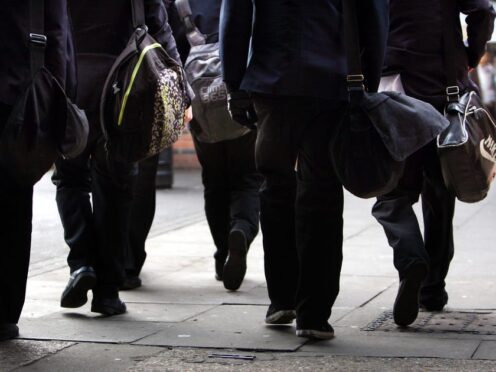
The number of pupil suspensions in England has risen by nearly a third in a year to more than 260,000, Government figures show.
Data from the Department for Education (DfE) shows there were 263,904 suspensions in the spring term of 2022/23, compared to 201,090 during the spring term of 2021/22 – a rise of 31%.
The number of suspensions in spring 2023 is the “highest” termly figure recorded, the DfE said.
Suspensions are typically higher in the autumn term, but the figures show the number rose by 7% from autumn 2022 (when there were 247,366 suspensions) to spring 2023.
The rise of suspensions – which are when a pupil is excluded from a school for a set period of time – comes amid warnings of challenging behaviour in classrooms following the Covid-19 pandemic.
The number of permanent exclusions also increased in the spring term of last year compared to the same period in 2022.
There were 3,039 permanent exclusions in spring 2023, compared to 2,179 in spring 2022 – a rise of 39%, the figures show.
The most common reason for suspensions and permanent exclusions was persistent disruptive behaviour, the DfE said.
Paul Whiteman, general secretary at school leaders’ union NAHT, said: “It is undoubtedly a real cause for concern that suspensions and exclusions have increased year-on-year and that the number of suspensions is the highest termly figure on record.
“This is something the Government should reflect on.
“Schools work incredibly hard to support pupils who are struggling with behaviour issues, but often the issues underpinning this go way beyond the school gate.
“Too often schools are left to tackle the problems that lead to exclusions and suspensions alone, and with scarce resources.”
He added: “Without more government investment in these vital services, challenges in children’s lives will continue to affect their behaviour, wellbeing and academic achievement.”
Pepe Di’Iasio, general secretary of the Association of School and College Leaders, said: “This data unfortunately reflects what we are hearing from school leaders across the country – that there is a really difficult situation with challenging behaviour among some pupils.”
He added: “The whole tapestry of social and mental health support services around families and children has receded over the past 14 years because of budget pressures and increasing demand, and schools are left to pick up the pieces without sufficient funding.
“This means that behavioural issues often escalate to a point at which a suspension – or exclusion – is the only option that is left. It is a terrible legacy of government underinvestment.”
Beth Prescott, education lead at the Centre for Social Justice think tank, said the figures reveal “an unfolding crisis” in the number of school suspensions.
She added that the pandemic, cost-of-living crisis, and the rise in the level of special education needs and disabilities (Send) are “contributing to a tidal wave of challenges hitting children, families and schools.”
Ms Prescott said: “This is being played out across our education system, with record levels of suspensions and record levels of children severely absent from school.”
A DfE spokesperson said: “The Government is very clear it backs head teachers to use exclusions where required, so they can provide calm, safe and supportive environments for children to learn in.
“We are providing targeted support to schools to help improve behaviour, attendance and reduce the risk of exclusions with an investment of £10 million in our Behaviour Hubs programme, and our mental health teams who will reach at least 50% of pupils by 2025.
“We are continuing to deliver on our plan to give every child a world class education and standards have risen sharply across the country, with 90% of schools now rated good or outstanding by Ofsted, up from just 68% in 2010.”

Enjoy the convenience of having The Sunday Post delivered as a digital ePaper straight to your smartphone, tablet or computer.
Subscribe for only £5.49 a month and enjoy all the benefits of the printed paper as a digital replica.
Subscribe